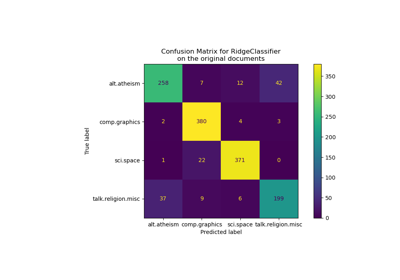Note
Go to the end to download the full example code or to run this example in your browser via JupyterLite or Binder.
Sample pipeline for text feature extraction and evaluation#
The dataset used in this example is The 20 newsgroups text dataset which will be automatically downloaded, cached and reused for the document classification example.
In this example, we tune the hyperparameters of a particular classifier using a
RandomizedSearchCV. For a demo on the
performance of some other classifiers, see the
Classification of text documents using sparse features
notebook.
# Authors: The scikit-learn developers
# SPDX-License-Identifier: BSD-3-Clause
Data loading#
We load two categories from the training set. You can adjust the number of
categories by adding their names to the list or setting categories=None when
calling the dataset loader fetch_20newsgroups to get
the 20 of them.
from sklearn.datasets import fetch_20newsgroups
categories = [
"alt.atheism",
"talk.religion.misc",
]
data_train = fetch_20newsgroups(
subset="train",
categories=categories,
shuffle=True,
random_state=42,
remove=("headers", "footers", "quotes"),
)
data_test = fetch_20newsgroups(
subset="test",
categories=categories,
shuffle=True,
random_state=42,
remove=("headers", "footers", "quotes"),
)
print(f"Loading 20 newsgroups dataset for {len(data_train.target_names)} categories:")
print(data_train.target_names)
print(f"{len(data_train.data)} documents")
Loading 20 newsgroups dataset for 2 categories:
['alt.atheism', 'talk.religion.misc']
857 documents
Pipeline with hyperparameter tuning#
We define a pipeline combining a text feature vectorizer with a simple classifier yet effective for text classification.
from sklearn.feature_extraction.text import TfidfVectorizer
from sklearn.naive_bayes import ComplementNB
from sklearn.pipeline import Pipeline
pipeline = Pipeline(
[
("vect", TfidfVectorizer()),
("clf", ComplementNB()),
]
)
pipeline
We define a grid of hyperparameters to be explored by the
RandomizedSearchCV. Using a
GridSearchCV instead would explore all the
possible combinations on the grid, which can be costly to compute, whereas the
parameter n_iter of the RandomizedSearchCV
controls the number of different random combination that are evaluated. Notice
that setting n_iter larger than the number of possible combinations in a
grid would lead to repeating already-explored combinations. We search for the
best parameter combination for both the feature extraction (vect__) and the
classifier (clf__).
import numpy as np
parameter_grid = {
"vect__max_df": (0.2, 0.4, 0.6, 0.8, 1.0),
"vect__min_df": (1, 3, 5, 10),
"vect__ngram_range": ((1, 1), (1, 2)), # unigrams or bigrams
"vect__norm": ("l1", "l2"),
"clf__alpha": np.logspace(-6, 6, 13),
}
In this case n_iter=40 is not an exhaustive search of the hyperparameters’
grid. In practice it would be interesting to increase the parameter n_iter
to get a more informative analysis. As a consequence, the computional time
increases. We can reduce it by taking advantage of the parallelisation over
the parameter combinations evaluation by increasing the number of CPUs used
via the parameter n_jobs.
from pprint import pprint
from sklearn.model_selection import RandomizedSearchCV
random_search = RandomizedSearchCV(
estimator=pipeline,
param_distributions=parameter_grid,
n_iter=40,
random_state=0,
n_jobs=2,
verbose=1,
)
print("Performing grid search...")
print("Hyperparameters to be evaluated:")
pprint(parameter_grid)
Performing grid search...
Hyperparameters to be evaluated:
{'clf__alpha': array([1.e-06, 1.e-05, 1.e-04, 1.e-03, 1.e-02, 1.e-01, 1.e+00, 1.e+01,
1.e+02, 1.e+03, 1.e+04, 1.e+05, 1.e+06]),
'vect__max_df': (0.2, 0.4, 0.6, 0.8, 1.0),
'vect__min_df': (1, 3, 5, 10),
'vect__ngram_range': ((1, 1), (1, 2)),
'vect__norm': ('l1', 'l2')}
Fitting 5 folds for each of 40 candidates, totalling 200 fits
Done in 26.507s
print("Best parameters combination found:")
best_parameters = random_search.best_estimator_.get_params()
for param_name in sorted(parameter_grid.keys()):
print(f"{param_name}: {best_parameters[param_name]}")
Best parameters combination found:
clf__alpha: 0.01
vect__max_df: 0.2
vect__min_df: 1
vect__ngram_range: (1, 1)
vect__norm: l1
test_accuracy = random_search.score(data_test.data, data_test.target)
print(
"Accuracy of the best parameters using the inner CV of "
f"the random search: {random_search.best_score_:.3f}"
)
print(f"Accuracy on test set: {test_accuracy:.3f}")
Accuracy of the best parameters using the inner CV of the random search: 0.816
Accuracy on test set: 0.709
The prefixes vect and clf are required to avoid possible ambiguities in
the pipeline, but are not necessary for visualizing the results. Because of
this, we define a function that will rename the tuned hyperparameters and
improve the readability.
import pandas as pd
def shorten_param(param_name):
"""Remove components' prefixes in param_name."""
if "__" in param_name:
return param_name.rsplit("__", 1)[1]
return param_name
cv_results = pd.DataFrame(random_search.cv_results_)
cv_results = cv_results.rename(shorten_param, axis=1)
We can use a plotly.express.scatter to visualize the trade-off between scoring time and mean test score (i.e. “CV score”). Passing the cursor over a given point displays the corresponding parameters. Error bars correspond to one standard deviation as computed in the different folds of the cross-validation.
import plotly.express as px
param_names = [shorten_param(name) for name in parameter_grid.keys()]
labels = {
"mean_score_time": "CV Score time (s)",
"mean_test_score": "CV score (accuracy)",
}
fig = px.scatter(
cv_results,
x="mean_score_time",
y="mean_test_score",
error_x="std_score_time",
error_y="std_test_score",
hover_data=param_names,
labels=labels,
)
fig.update_layout(
title={
"text": "trade-off between scoring time and mean test score",
"y": 0.95,
"x": 0.5,
"xanchor": "center",
"yanchor": "top",
}
)
fig
Notice that the cluster of models in the upper-left corner of the plot have the best trade-off between accuracy and scoring time. In this case, using bigrams increases the required scoring time without improving considerably the accuracy of the pipeline.
Note
For more information on how to customize an automated tuning to maximize score and minimize scoring time, see the example notebook Custom refit strategy of a grid search with cross-validation.
We can also use a plotly.express.parallel_coordinates to further visualize the mean test score as a function of the tuned hyperparameters. This helps finding interactions between more than two hyperparameters and provide intuition on their relevance for improving the performance of a pipeline.
We apply a math.log10 transformation on the alpha axis to spread the
active range and improve the readability of the plot. A value \(x\) on
said axis is to be understood as \(10^x\).
import math
column_results = param_names + ["mean_test_score", "mean_score_time"]
transform_funcs = dict.fromkeys(column_results, lambda x: x)
# Using a logarithmic scale for alpha
transform_funcs["alpha"] = math.log10
# L1 norms are mapped to index 1, and L2 norms to index 2
transform_funcs["norm"] = lambda x: 2 if x == "l2" else 1
# Unigrams are mapped to index 1 and bigrams to index 2
transform_funcs["ngram_range"] = lambda x: x[1]
fig = px.parallel_coordinates(
cv_results[column_results].apply(transform_funcs),
color="mean_test_score",
color_continuous_scale=px.colors.sequential.Viridis_r,
labels=labels,
)
fig.update_layout(
title={
"text": "Parallel coordinates plot of text classifier pipeline",
"y": 0.99,
"x": 0.5,
"xanchor": "center",
"yanchor": "top",
}
)
fig
The parallel coordinates plot displays the values of the hyperparameters on different columns while the performance metric is color coded. It is possible to select a range of results by clicking and holding on any axis of the parallel coordinate plot. You can then slide (move) the range selection and cross two selections to see the intersections. You can undo a selection by clicking once again on the same axis.
In particular for this hyperparameter search, it is interesting to notice that
the top performing models do not seem to depend on the regularization norm,
but they do depend on a trade-off between max_df, min_df and the
regularization strength alpha. The reason is that including noisy features
(i.e. max_df close to \(1.0\) or min_df close to \(0\)) tend to
overfit and therefore require a stronger regularization to compensate. Having
less features require less regularization and less scoring time.
The best accuracy scores are obtained when alpha is between \(10^{-6}\)
and \(10^0\), regardless of the hyperparameter norm.
Total running time of the script: (0 minutes 28.697 seconds)
Related examples

Classification of text documents using sparse features

Comparing Random Forests and Histogram Gradient Boosting models

Comparing randomized search and grid search for hyperparameter estimation
